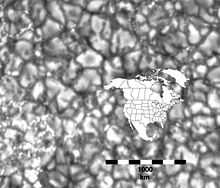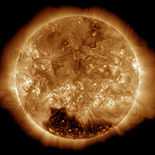Granule (solar physics)

Granules on the photosphere of the Sun are caused by convection currents (thermal columns, Bénard cells) of plasma within the Sun's convective zone. The grainy appearance of the solar photosphere is produced by the tops of these convective cells and is called granulation.
The rising part of the granules is located in the center where the plasma is hotter. The outer edge of the granules is darker due to the cooler descending plasma. In addition to the visible appearance, which would be explained by convective motion, Doppler shift measurements of the light from individual granules provides evidence for the convective nature of the granules.
A typical granule has a diameter on the order of 1,500 kilometers[1] and lasts 8 to 20 minutes before dissipating. At any one time, the Sun's surface is covered by about 4 million granules. Below the photosphere is a layer of "supergranules" up to 30,000 kilometers in diameter with lifespans of up to 24 hours.
References
- ↑ Zirker, J. B. (2003). Sunquakes. Johns Hopkins University Press. p. 2.
| |||||||||||||||||||||||||||||||||||||||
